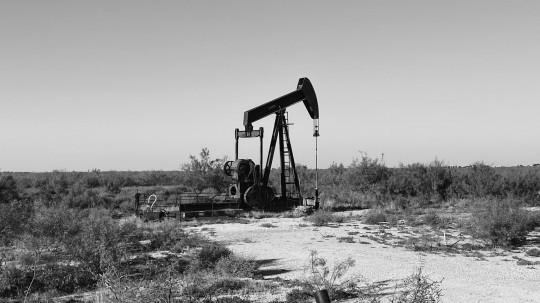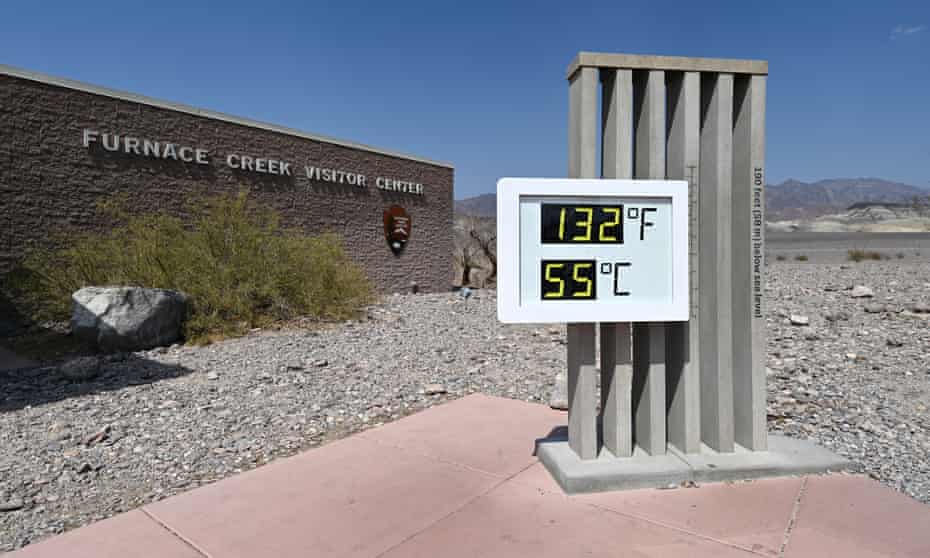Saskatchewan
Opposing protests about public health mandates remain peaceful at Legislative Building
Concrete barricades have been put in place to prevent vehicle access
People from two opposing protests are outside the Legislative Building in Regina Saturday afternoon — one group calling for an end to COVID-19 public health measures while the other asks they remain in place.
At about 2 p.m., there were hundreds of demonstrators asking for an end to mandates while a smaller group countered their calls. So far, the conflicting protests appear to be peaceful.
Concrete barricades currently block vehicles from accessing the Legislative Building.
Some anti-mandate protesters arrived in Regina as part of several convoys. Organizers say they plan to stay in the area until all public health restrictions in Saskatchewan are lifted.
Demonstrators calling for an end to mandates are carrying signs with messages such as "Unmask the Hoax" and "Vaxx Useless."
Premier Scott Moe has already promised to lift all restrictions soon.
Kristen Dube, an anti-mandate protester who drove to the event from Saskatoon, says she is vaccinated and her partner is not.
"I think people wearing masks, people not wearing masks, vaccinated, unvaccinated as a couple, we can still unite our country and we can still stand for more than just COVID," Dube said.
"We need to support our hospitals. We need to support our health-care workers that have been on those front lines. And I think that the money that's currently being spent on COVID passports alone should be allocated to things that are more useful to us as a community and as people of Canada and Saskatchewan."
Aran McCallen also made the trip down to Regina from Saskatoon.
"I believe in freedom of choice. I don't think that the government should be able to force you to do anything," McCallen said.
Pro-mandate protesters
At the same time, a second protest called Take Action Against COVID is calling for the provincial government to do the opposite and maintain the public health measures that Premier Scott Moe is planning to abandon.
Organizers of that event say the premier is doing away with mandates to "please anti-vax extremists." They say the vaccine passport has to be kept so that businesses can keep both customers and staff safe.
"We need public health measures to protect people and our economy in the middle of a pandemic. We need a provincial government that listens to its own experts and does not abandon us or our children to Omicron," organizers said in an email notice about the protest.
"We need leaders who will not let our medical system burn down around us by letting critical-care doctors and nurses burn out at record speed."
Signs carried by pro-mandate demonstrators say "Protect healthcare workers" and "Spread [love]."
Pro-mandate organizers are calling for the premier and his ministers to resign if they do not maintain COVID-19 mandates and restrictions in the province.
"I'm here because I want the freedom protesters to know that they don't represent me … I believe that with the rights that we do have … we have responsibilities to everybody else that lives in our country, our province, our world," said Krista Notenboom, a pro-mandate demonstrator from Regina.
"I'm frustrated about the restrictions and the pandemic, and continuing to have to wear masks. But I'm not willing to not look after my fellow citizens to get rid of my mask."
Lukas Miller, a health-care worker who showed up to back COVID-19 restrictions and mandates, says he wants Moe to listen to doctors and scientists.
"Basically every day of my job since COVID started has been doing research on COVID-19 — efficacy of vaccines, how much it spreads — and I see a lot of that information, and I don't really know how Scott Moe is coming up with the decisions he has, based on what I've seen," Miller said.
"Now, I'm not an expert, but neither is he, so I think people need to listen to our medical community a little closer."
Protesters against, for COVID restrictions gather near Legislature

Protesters near the Legislature in Regina on Feb. 5, 2022. (Dominick Lucyk/980 CJME)
It didn’t bring the kind of massive gridlock and constant noise that the previous one did, but there was another protest against COVID restrictions at the Legislature in Regina on Saturday.
People gathered on Albert Street by the entrance to the legislative grounds to hold signs and wave, while those who supported their cause drove by and honked.
None of those in trucks or other vehicles were able to enter the grounds of the Legislature, because it was blocked off with a concrete barrier. That was because of the Frost Regina winter festival.
There was also another, smaller group of protesters that came to call on the Moe government to keep up COVID restrictions like a vaccine passport and mandatory masking.
It was led by Saskatchewan Liberal Party Leader Jeff Walters.
Former Saskatchewan Party MLA Greg Brkich showed up in support of those who want to end the mandates.
When asked what he thought of Premier Scott Moe’s recent hints at ending COVID restrictions, he said he’d love to see it, but he still felt the need to put pressure on the provincial government.
“It sends a message to him. That’s why I came, (to) tell him it’s time. Instead of waiting two, three, four, five weeks, it’s time now. That’s why I came, to tell him it’s time to lift them. Lift the mandates and move on,” Brkich said.
As a long-time MLA, Brkich believes in getting in touch with politicians when you want to see change.
“I tell people, ‘Phone your MLA,’ because that counts. You may not think it does, but you write down the calls you get, and then you talk at caucus. And all of the MLAs sit around, ‘Yeah, I got 200 calls, I got 100, I got 300,’ ” he said.
Walters was on the opposite end. He said now is just not the time to be easing up on the virus.
“At the end of the day, we’re still in the midst of the peak of a pandemic as we talk right now. To have our leaders in government right now essentially suggesting they’re pulling back everything, in the midst of a raging pandemic, to me just makes absolutely no sense and it goes against the advice of almost every expert on the planet,” he said.
When asked what would be needed to reach a point where restrictions can be lifted, Walters didn’t name anything specific.
“Thresholds are interesting because you can go down that rabbit hole, and you’re never going to please everybody when you talk thresholds. But the point of it is, if you have, say, a health and social policy council made up of experts and advisors that can tackle those issues and give you options, as a leader that makes the most sense,” he said.
“I don’t think politicians necessarily are experts in science or medicine, and I think that we should leave it to the experts to help us guide through it.”
Protesters on both sides who preferred to stay anonymous also shared their thoughts.
980 CJME asked a man in favour of dropping COVID rules why he chose to protest, given Moe’s promises to do just that.
“As long as he’s true to his word. We’ve seen so much lying from politicians all across this country. I hope he’s true to his word, because the Charter of Rights and Freedoms has been stepped on,” he said.
A man on the other side of the debate said now is just not the time.
“I’m all for restrictions being lifted. They have to be lifted at some point. But right now, Saskatchewan is leading the way in hospitalizations, as far as they’re increasing at a faster rate than anywhere else in Canada. We should be looking at hospitalizations and ICU admissions, and then, once those are going down, then we should be looking at lifting restrictions,” he said
Author of the article:Bruce Ziff
Publishing date:Feb 05, 2022 • 1 day ago • 3 minute read • 111 Comments
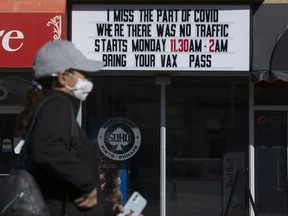
Article content
The Edmonton Journal reports that there is talk of removing the vaccine passport system in Alberta in the name of freedom. That would be counter-productive and inequitable. Yes, inequitable.
At its core, freedom is about the right to make unfettered choices. Yet, the concept of freedom is more complicated than one might think. Sometimes it refers to “negative” freedom, that is, freedom from state-imposed restrictions. That’s the kind of freedom that truckers and like-minded protesters are so adamant to preserve.
But freedom has another connotation. It means empowerment. For example, those who are wealthy are free to spend their life as they wish. They have plenty of “free” time. It’s no wonder, then, that lottery commercials advise that the real prize of winning the jackpot is freedom. The winner is now more fully in control of their life choices. That kind of liberty is constrained by factors other than the law. We are all free to buy a Porsche; there is no law against it. But not all of us can realistically make that choice.
It is understandable that Albertans want both kinds of freedom, and as much as is possible. But, unfortunately, that is sometimes easier said than done. Consider now the vaccine passport. The premier is considering dismantling the system. Negative freedom is thereby increased. The government loosens its control on where we can and cannot go. But let’s think about how that will affect our individual and collective empowerment on the ground.
I, for one, have felt able to resume some of my pre-COVID activities under the passport system. I can work out at the gym, or go to a restaurant with some level of assurance that I will not contract COVID. When passports are no longer required, more people will be free to exercise or dine out in public spaces including those who are not vaccinated. I probably will not do so. I will choose to forego these simple pleasures. There is no question that my range of life choices is abridged.
For me, the greatest actual limit on my autonomy is not the law, but the well-grounded fear of a breakthrough case of Omricon. (If you doubt that this concern is well-founded, then stop reading now. I read the papers. I know what COVID can do.)
Removing the passport requirement reduces my life choices. So do -30 C temperatures. I am free — in the negative liberty sense — to spend hours freezing outside or sleep under a bridge, but these are not real choices. I am free to mingle with non-vaxxers, but that would entail too much risk.
I am not alone. If non-vaxxers can go to gyms and restaurants, I suspect many of those who are taking sensible precautions will not. It is in this sense that freedom operates like a zero-sum game, where the benefits given to one group are offset by the losses suffered by another.
Of course, we cannot calculate the overall freedom quotient by running data through a Freedomatron-2000 computer, but we at least know that some people will restrict their activities once the passport rules are lifted. Since a majority of Albertans are vaccinated, we are optimizing the choices of an unvaccinated minority at the expense of the majority. We have lost the freedom to dine, et cetera in safe (safer) public spaces. Why does that make sense?
Here is a reality check. Those who prize some general notion of freedom should ask themselves this: since March 2020, what has actually caused you to adjust your lifestyle the most on a daily basis? Is it government action or the virus itself?
Put another way, imagine how life would have been had no government measures been taken to control the spread of COVID? I suspect that each day would have involved an evermore dangerous game of cat and mouse against the Grim Reaper. It’s the plague that is ruining our lives, and throttling our freedom, and those who understand that deserve the larger share of the freedom pie.
Bruce Ziff is a professor emeritus in the faculty of law at the University of Alberta.
A study into malaria resistance in humans spurs a re-evaluation of the neo-Darwinist understanding of evolution
By MATTHEW ROZSA
PUBLISHED FEBRUARY 5, 2022
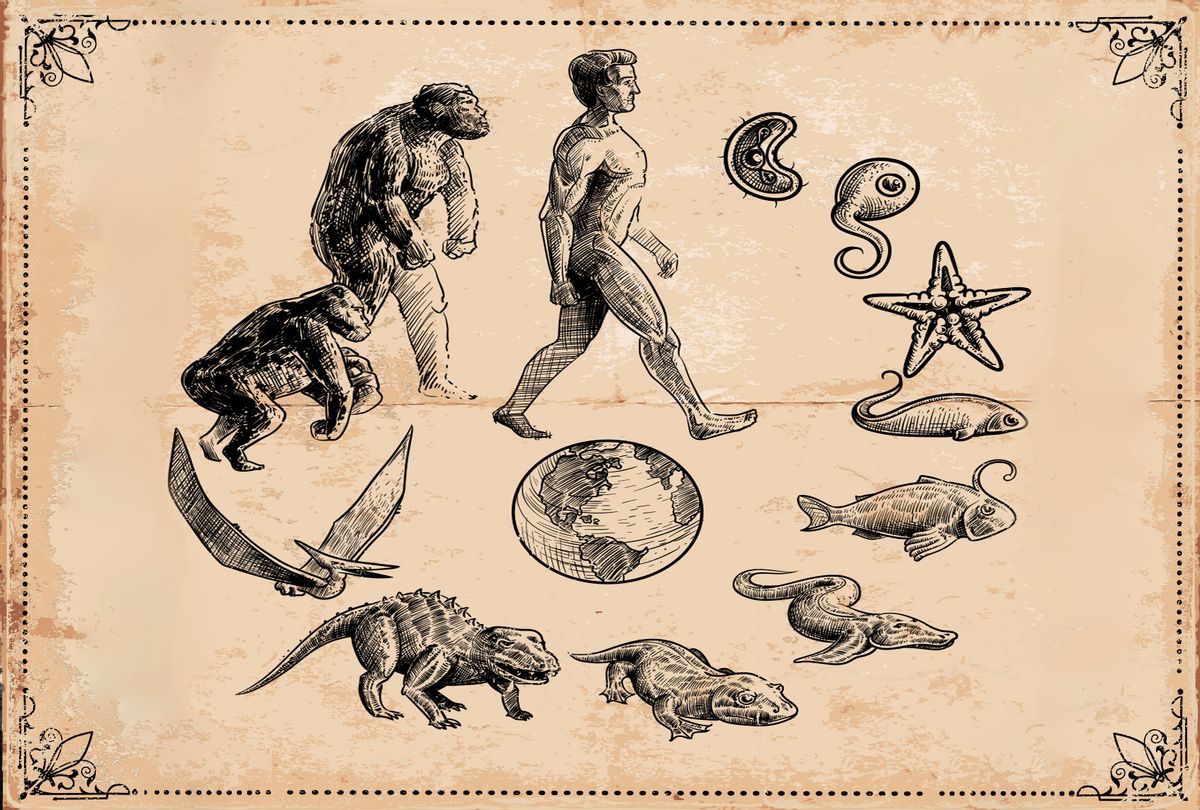
A peculiar study into malaria resistance in humans, and where and how it occurs in the population, has unexpectedly spurred a re-evaluation of the neo-Darwinist understanding of evolution.
Neo-Darwinism refers to any branch of science which combines Charles Darwin's theory of evolution by natural selection with Gregor Mendel's discipline of genetics. The overwhelming majority of biologists and geneticists are neo-Darwinists, and one primary tenet of neo-Darwinism is the idea that the genetic mutations which cause living creatures to evolve occur randomly. For humans, this means that mutations from the entirely beneficial (opposable thumbs) and the undesirable (say, those which cause obstructive sleep apnea) can be attributed to chance rather than some kind of purposeful direction. The ones that get passed on permanently do so through natural selection — that is, because they just so happen to help their hosts, who then survive longer and have more opportunities to perpetuate the mutation via reproduction.
At least, that was the prevailing assumption. A new study led by researchers from Israel and Ghana and published in the journal Genome Research reveals that, in fact, at least one helpful genetic mutation was not random at all. They specifically studied the HbS mutation, which protects people against malaria, and found that it arose more frequently within a population where malaria is endemic (Africa) than within a population where it is not (Europe). This might cause some of neo-Darwinism's tenets to be revised.
RELATED: Science quietly wins one of the right's longstanding culture wars
"The results showed that the malaria resistant HbS mutation arises more frequently in the population and gene where it is of adaptive significance," Dr. Adi Livnat from the University of Haifi, the study's lead researcher and corresponding author, told Salon by email. "This shows empirically for the first time a directional response of mutation to a specific long-term environmental pressure. This sort of result cannot be explained by neo-Darwinism, which is limited to explaining minor, gross-level effects on average mutation rates, not responses of specific mutations to specific environmental pressures. Therefore, the implications are that here there is an empirical finding that neo-Darwinism really cannot explain, which challenges the notion of random mutation on a fundamental level."
Want more health and science stories in your inbox? Subscribe to Salon's weekly newsletter The Vulgar Scientist.
Speaking to The Jerusalem Post, Livnat speculated that evolution could actually be shaped by a combination of "external information" through natural selection and "internal information" that is picked up in the human genome from generation to generation and leads to the creation of mutations.
"The research tells us many things, including the fact that the origination rate of the HbS mutation cannot be explained from the perspective of neo-Darwinism," Livnat told Salon.
Livnat and the team of scientists were able to learn something this monumental once they had developed new technology for detecting de novo mutations, meaning those which are not passed down to the child from either parent. With a higher resolution, the scientists were able to count individual novel mutations on specific areas of the genome where they might find something instructive. The human hemoglobin S mutation (HbS) was chosen as their subject of study; neo-Darwinism contends that it originated randomly in a sub-Saharan African individual and spread in that region through natural selection because (despite being associated with sickle-cell anemia) it conferred malaria-protecting benefits. Yet if that theory were accurate, the mutation would still be random and therefore appear in roughly equal numbers between a population that is not heavily exposed to malaria (Europe's) and one that is (Africa's).
This was not the case.
"The HbS mutation originated de novo not only much faster than expected from random mutation but also much faster in the population (in sub-Saharan Africans as opposed to Europeans) and in the gene (in the beta-globin as opposed to the control delta-globin gene) where it is of adaptive significance," the University of Haifa announced in a statement.
In addition, the study gives scientists strong reason to reconsider their current practice of measuring mutation rates as averages across a multitude of positions on the genome.
"We can definitively see that the picture of mutation origination that is obtained once we examine the resolution of specific mutations could not have been expected from traditional theories or previous empirical studies," Livnat explained. "This suggests that most of the signal of mutation rates is not in the averages of mutation rates across many positions but is rather mutation specific. This means that there is an enormous amount of research to be done on how mutations are generated, and that already at the first time mutation origination is observed at this high resolution, we obtain results that challenge the central neo-Darwinian assumption on a fundamental level."
Dark matter travelling through stars could produce potentially detectable shock waves
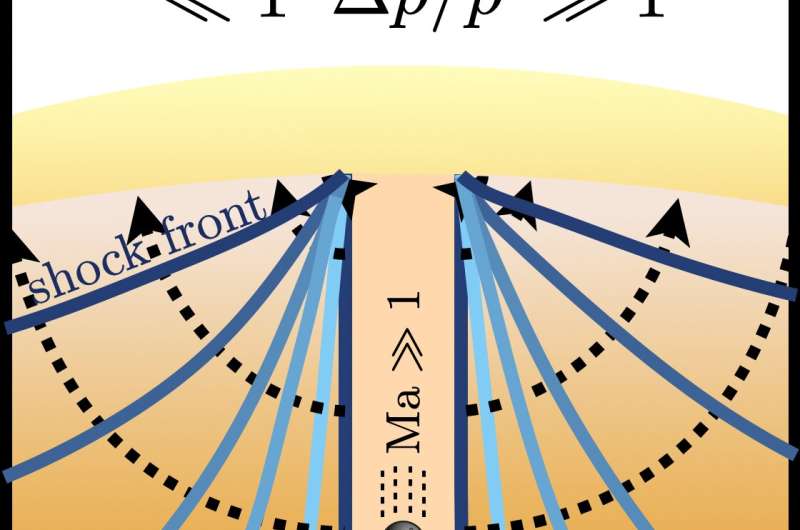
Dark matter, a hypothetical material that does not absorb, emit or reflect light, is thought to account for over 80 percent of the matter in the universe. While many studies have indirectly hinted at its existence, so far, physicists have been unable to directly detect dark matter and thus to confidently determine what it consists of.
One factor that makes searching for dark matter particularly challenging is that very little is known about its possible mass and composition. This means that dark matter searches are based on great part on hypotheses and theoretical assumptions.
Researchers at SLAC National Accelerator Laboratory and Université Paris Saclay have recently carried out a theoretical study that could introduce a new way of searching for dark matter. Their paper, published in Physical Review Letters, shows that when macroscopic dark matter travels through a star, it could produce shock waves that might reach the star's surface. These waves could in turn lead to distinctive and transient optical, UV and X-ray emissions that might be detectable by sophisticated telescopes.
"Most experiments have searched for dark matter made of separate particles, each about as heavy as an atomic nucleus, or clumps about as massive as planets or stars," Kevin Zhou, one of the researchers who carried out the study, told Phys.org. "We were interested in the intermediate case of asteroid-sized dark matter, which had been thought to be hard to test experimentally, since dark asteroids would be too rare to impact Earth, but too small to see in space."
Initially, Zhou and his colleagues started exploring the possibility that the heat produced during the impact between a dark matter asteroid and an ordinary star could result in the star exploding. This hypothesis was based on past studies suggesting that energy deposition can sometimes trigger supernova in white dwarfs. After a few weeks of calculations and discussions, however, the team realized that the impact between a dark matter asteroid and an ordinary star would most likely not lead to an explosion, as ordinary stars are more stable than white dwarfs.
"We had a hunch that the energy produced by such a collision should be visible somehow, so we brainstormed for a few months, trying and tossing out idea after idea," Zhou explained. "Finally, we realized that the shock waves generated by the dark asteroid's travel through the star were the most promising signature."

Shock waves are sharp signals that are produced when an object is moving faster than the speed of sound. For instance, a supersonic aircraft produces a sonic boom, which can be heard from the Earth's surface even when it is flying miles above it.
Similarly, Zhou and his colleagues predicted that the shock waves produced by dark asteroids deep inside a star could reach a star's surface. This would in turn result in a short-lived hot spot that could be detected using telescopes that can examine the UV spectrum.
"We're excited that we identified a powerful new way to search for a kind of dark matter thought to be hard to test, using telescopes that we already have in an unexpected way," Zhou said. "The most powerful UV telescope is the Hubble space telescope, but since stellar shock events are transients, it helps to be able to monitor more of the sky at once."
The recent study follows a growing trend within the astrophysics community to use astronomical objects as enormous dark matter detectors. This promising approach to searching for dark matter unites the fields of particle physics and astrophysics, bringing these two communities closer together.
In the future, the recent work by this team of researchers could inspire engineers to build new and smaller UV telescopes that can observe wider parts of the universe. A similar telescope, dubbed ULTRASAT, is already set to be released in 2024. Using this telescope, physicists could try searching for dark matter by examining stellar surfaces. In their next works, the researchers themselves plan to try to detect potential dark asteroid impact events using UV telescope data.
"The ideal case would be to use the Hubble space telescope to monitor a large globular cluster in the UV," Zhou said. "It would also be interesting to consider dark asteroids impacting other astronomical objects. Since our work, there have been papers by others considering impacts on neutron stars and red giants, but there are probably even more promising ideas in this direction that nobody has thought of yet."Physicist seeks to understand dark matter with Webb Telescope
More information: Anirban Das et al, Stellar Shocks from Dark Matter Asteroid Impacts, Physical Review Letters (2022). DOI: 10.1103/PhysRevLett.128.021101
Journal information: Physical Review Letters
© 2022 Science X Network
NASA Proposes a Way That Dark Matter’s Influence Could Be Directly Observed
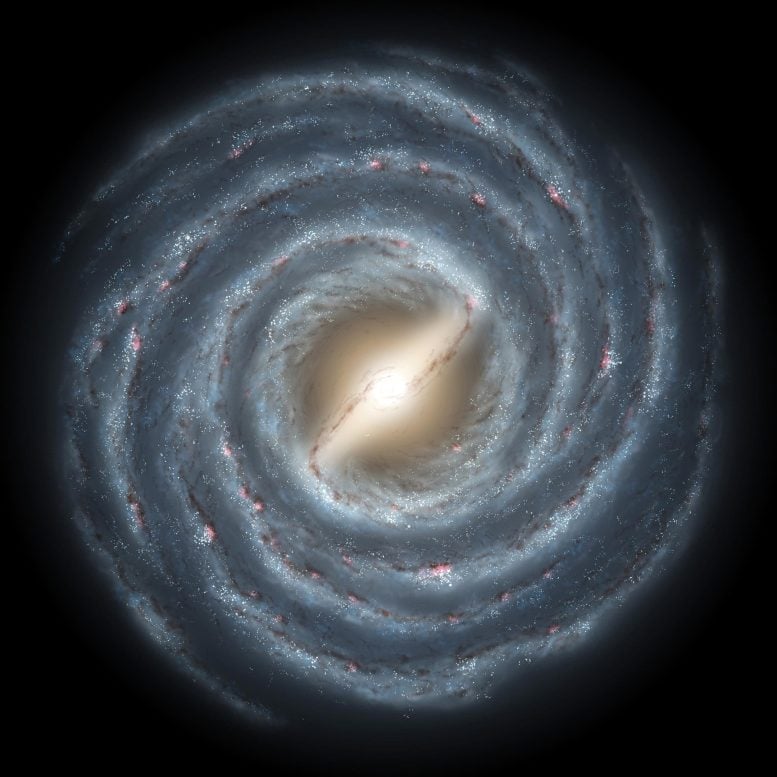
This artist’s rendering shows a view of our own Milky Way Galaxy and its central bar as it might appear if viewed from above. Credit: NASA/JPL-Caltech/R. Hurt (SSC)
How Dark Matter Could Be Measured in the Solar System
Pictures of the Milky Way show billions of stars arranged in a spiral pattern radiating out from the center, with illuminated gas in between. But our eyes can only glimpse the surface of what holds our galaxy together. About 95 percent of the mass of our galaxy is invisible and does not interact with light. It is made of a mysterious substance called dark matter, which has never been directly measured.
Now, a new study calculates how dark matter’s gravity affects objects in our solar system, including spacecraft and distant comets. It also proposes a way that dark matter’s influence could be directly observed with a future experiment. The article is published in the Monthly Notices of the Royal Astronomical Society.
“We’re predicting that if you get out far enough in the solar system, you actually have the opportunity to start measuring the dark matter force,” said Jim Green, study co-author and advisor to NASA’s Office of the Chief Scientist. “This is the first idea of how to do it and where we would do it.”
Dark matter in our backyard
Here on Earth, our planet’s gravity keeps us from flying out of our chairs, and the Sun’s gravity keeps our planet orbiting on a 365-day schedule. But the farther from the Sun a spacecraft flies, the less it feels the Sun’s gravity, and the more it feels a different source of gravity: that of the matter from the rest of the galaxy, which is mostly dark matter. The mass of our galaxy’s 100 billion stars is minuscule compared to estimates of the Milky Way’s dark matter content.
To understand the influence of dark matter in the solar system, lead study author Edward Belbruno calculated the “galactic force,” the overall gravitational force of normal matter combined with dark matter from the entire galaxy. He found that in the solar system, about 45 percent of this force is from dark matter and 55 percent is from normal, so-called “baryonic matter.” This suggests a roughly half-and-half split between the mass of dark matter and normal matter in the solar system.
“I was a bit surprised by the relatively small contribution of the galactic force due to dark matter felt in our solar system as compared to the force due to the normal matter,” said Belbruno, mathematician and astrophysicist at Princeton University and Yeshiva University. “This is explained by the fact most of dark matter is in the outer parts of our galaxy, far from our solar system.”
A large region called a “halo” of dark matter encircles the Milky Way and represents the greatest concentration of the dark matter of the galaxy. There is little to no normal matter in the halo. If the solar system were located at a greater distance from the center of the galaxy, it would feel the effects of a larger proportion of dark matter in the galactic force because it would be closer to the dark matter halo, the authors said.
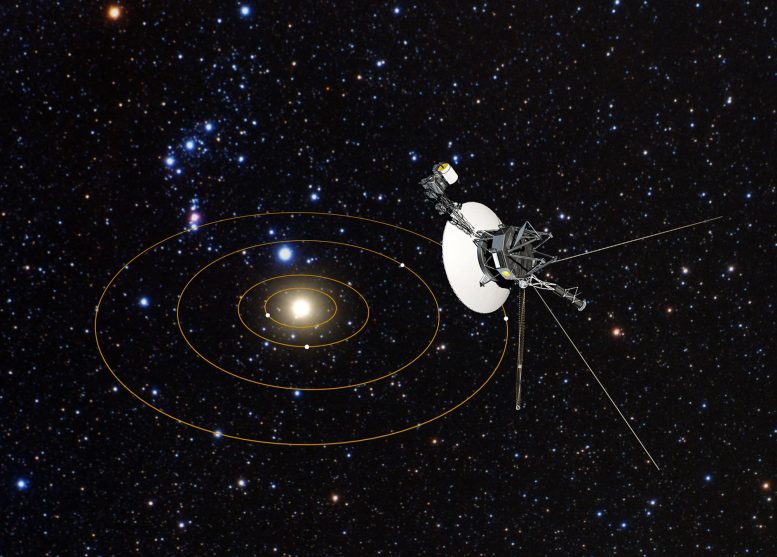
In this artist’s conception, NASA’s Voyager 1 spacecraft has a bird’s-eye view of the solar system. The circles represent the orbits of the major outer planets: Jupiter, Saturn, Uranus, and Neptune. Launched in 1977, Voyager 1 visited the planets Jupiter and Saturn. The spacecraft is now more than 14 billion miles from Earth, making it the farthest human-made object ever built. In fact, Voyager 1 is now zooming through interstellar space, the region between the stars that is filled with gas, dust, and material recycled from dying stars. Credit: NASA, ESA, and G. Bacon (STScI)
How dark matter may influence spacecraft
Green and Belbruno predict that dark matter’s gravity ever so slightly interacts with all of the spacecraft that NASA has sent on paths that lead out of the solar system, according to the new study.
“If spacecraft move through the dark matter long enough, their trajectories are changed, and this is important to take into consideration for mission planning for certain future missions,” Belbruno said.
Such spacecraft may include the retired Pioneer 10 and 11 probes that launched in 1972 and 1973, respectively; the Voyager 1 and 2 probes that have been exploring for more than 40 years and have entered interstellar space; and the New Horizons spacecraft that has flown by Pluto and Arrokoth in the Kuiper Belt.
But it’s a tiny effect. After traveling billions of miles, the path of a spacecraft like Pioneer 10 would only deviate by about 5 feet (1.6 meters) due to the influence of dark matter. “They do feel the effect of dark matter, but it’s so small, we can’t measure it,” Green said.
Where does the galactic force take over?
At a certain distance from the Sun, the galactic force becomes more powerful than the pull of the Sun, which is made of normal matter. Belbruno and Green calculated that this transition happens at around 30,000 astronomical units, or 30,000 times the distance from Earth to the Sun. That is well beyond the distance of Pluto, but still inside the Oort Cloud, a swarm of millions of comets that surrounds the solar system and extends out to 100,000 astronomical units.
This means that dark matter’s gravity could have played a role in the trajectory of objects like ‘Oumuamua, the cigar-shaped comet or asteroid that came from another star system and passed through the inner solar system in 2017. Its unusually fast speed could be explained by dark matter’s gravity pushing on it for millions of years, the authors say.
If there is a giant planet in the outer reaches of the solar system, a hypothetical object called Planet 9 or Planet X that scientists have been searching for in recent years, dark matter would also influence its orbit. If this planet exists, dark matter could perhaps even push it away from the area where scientists are currently looking for it, Green and Belbruno write. Dark matter may have also caused some of the Oort Cloud comets to escape the orbit of the Sun altogether.
Could dark matter’s gravity be measured?
To measure the effects of dark matter in the solar system, a spacecraft wouldn’t necessarily have to travel that far. At a distance of 100 astronomical units, a spacecraft with the right experiment could help astronomers measure the influence of dark matter directly, Green and Belbruno said.
Specifically, a spacecraft equipped with radioisotope power, a technology that has allowed Pioneer 10 and 11, the Voyagers, and New Horizon to fly very far from the Sun, may be able to make this measurement. Such a spacecraft could carry a reflective ball and drop it at an appropriate distance. The ball would feel only galactic forces, while the spacecraft would experience a thermal force from the decaying radioactive element in its power system, in addition to the galactic forces. Subtracting out the thermal force, researchers could then look at how the galactic force relates to deviations in the respective trajectories of the ball and the spacecraft. Those deviations would be measured with a laser as the two objects fly parallel to one another.
A proposed mission concept called Interstellar Probe, which aims to travel to about 500 astronomical units from the Sun to explore that uncharted environment, is one possibility for such an experiment.

Two views from Hubble of the massive galaxy cluster Cl 0024+17 (ZwCl 0024+1652) are shown. To the left is the view in visible-light with odd-looking blue arcs appearing among the yellowish galaxies. These are the magnified and distorted images of galaxies located far behind the cluster. Their light is bent and amplified by the immense gravity of the cluster in a process called gravitational lensing. To the right, a blue shading has been added to indicate the location of invisible material called dark matter that is mathematically required to account for the nature and placement of the gravitationally lensed galaxies that are seen. Credit: NASA, ESA, M.J. Jee and H. Ford (Johns Hopkins University)
More about dark matter
Dark matter as a hidden mass in galaxies was first proposed in the 1930s by Fritz Zwicky. But the idea remained controversial until the 1960s and 1970s, when Vera C. Rubin and colleagues confirmed that the motions of stars around their galactic centers would not follow the laws of physics if only normal matter were involved. Only a gigantic hidden source of mass can explain why stars at the outskirts of spiral galaxies like ours move as quickly as they do.
Today, the nature of dark matter is one of the biggest mysteries in all of astrophysics. Powerful observatories like the Hubble Space Telescope and the Chandra X-Ray Observatory have helped scientists begin to understand the influence and distribution of dark matter in the universe at large. Hubble has explored many galaxies whose dark matter contributes to an effect called “lensing,” where gravity bends space itself and magnifies images of more distant galaxies.
Astronomers will learn more about dark matter in the cosmos with the newest set of state-of-the-art telescopes. NASA’s James Webb Space Telescope, which launched Dec. 25, 2021, will contribute to our understanding of dark matter by taking images and other data of galaxies and observing their lensing effects. NASA’s Nancy Grace Roman Space Telescope, set to launch in the mid-2020s, will conduct surveys of more than a billion galaxies to look at the influence of dark matter on their shapes and distributions.
The European Space Agency’s forthcoming Euclid mission, which has a NASA contribution, will also target dark matter and dark energy, looking back in time about 10 billion years to a period when dark energy began hastening the universe’s expansion. And the Vera C. Rubin Observatory, a collaboration of the National Science Foundation, the Department of Energy, and others, which is under construction in Chile, will add valuable data to this puzzle of dark matter’s true essence.
But these powerful tools are designed to look for dark matter’s strong effects across large distances, and much farther afield than in our solar system, where dark matter’s influence is so much weaker.
“If you could send a spacecraft out there to detect it, that would be a huge discovery,” Belbruno said.
Reference: “When leaving the Solar system: Dark matter makes a difference” by Edward Belbruno and James Green, 4 January 2022, Monthly Notices of the Royal Astronomical Society.
DOI: 10.1093/mnras/stab3781




